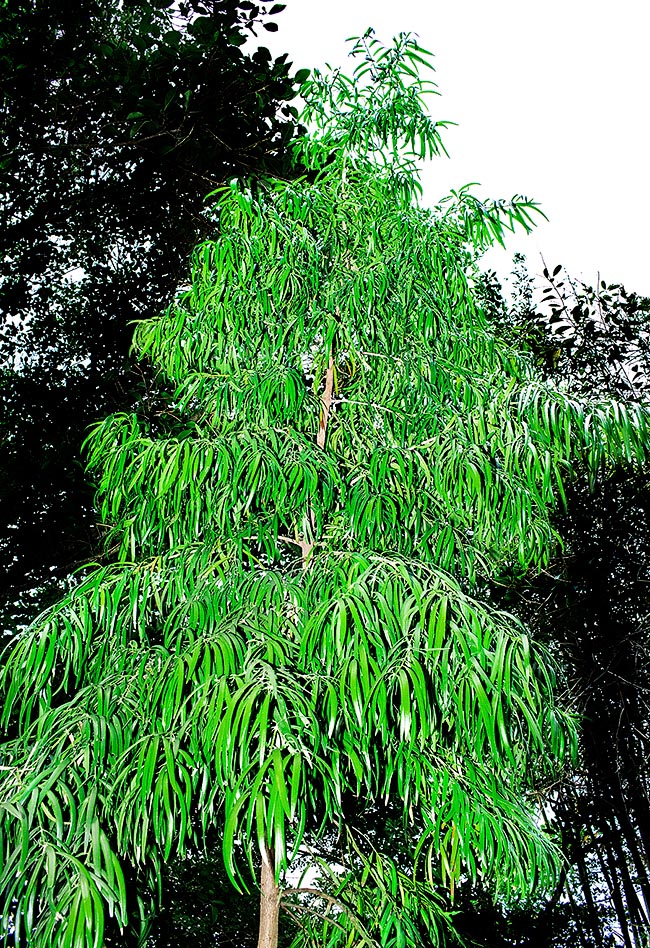Family : Podocarpaceae

Text © Pietro Puccio

English translation by Mario Beltramini
The species is native to north-western Australia (Northern Territory and Queensland) where it grows in the pluvial coastal forests, from the sea level up to about 900 m of altitude.
The name of the genus is the combination of the Greek substantives “πούς, ποδός” (pús, podόs) = foot and “καρπός” (karpόs) = fruit, with reference to the shape of the fruit of the first species described; the species is dedicated to the Mrs. Netta Elisabeth Gray, botanist, (1913-1970) who has done several researches in the genus.
Common names: brown pine, northern brown, northern brown pine, weeping brown pine (English).

Very decorative due to the intense glossy green leaves, Podocarpus grayae reaches in Australia the 40 m of height © Giuseppe Mazza
The Podocarpus grayae de Laub. (1985) is an evergreen dioecious tree having a thick canopy and trunk, up to 40 m of height and of 0,8-1,4 m of diameter in the old specimens in nature, with thin brown greyish bark that with the age tends to fissure and to flake off in thin longitudinal scales.
The leaves are simple, sessile or sub-sessile, pendulous, at times arranged in verticils of three or four in the young buds, alternate and oriented in various directions in the adult plants, linear-lanceolate with acute apex, entire margin and prominent central vein, coriaceous, initially yellow greenish, then glossy intense green, 10-25 cm long and 0,8-1,5 cm broad.
Axillar male cones sessile or sub-sessile, in groups of 1-4, cylindrical, 2-5 cm long and of about 0,4 cm of diameter, provided at the base of imbricate sterile bracts spirally arranged; microsporophylls (leaves modified that bear the pollen sacs) almost triangular, 1-2 mm long, each one bearing two pollen sacs. Female cones, on a 0,5-0,8 cm long peduncle, axillar, solitary, with two bracts merged and flesh when ripe to form the receptacle, initially green, then dark red, 1-1,6 cm long and of 0,8-1 cm of diameter, surmounted by an ovoid seed, 0,8-1,5 cm long and of 0,6-1 cm of diameter, covered by a thin flesh layer, called “epimatium”, glaucous.
It reproduces by seed, previously kept in water for two days, in draining loam maintained humid at the temperature of 24-26 °C.
Species with the foliage of great ornamental effect utilizable as isolated specimen or in group in the regions with tropical, subtropical and marginally in the mildest temperate-warm ones. It grows in full sun, excepting during the first years of life, as well as in partial shade and on various types of soil, provided draining, maintained almost constantly humid, has also a good resistance to the marine sprays. Of particular elegance cultivated in pot for the decoration of open spaces as well as of inner ones, even if little luminous, utilizing a fertile loam with addition of coarse sand or agri-perlite per a 30 %. The wood, of pale brown colour, of medium density, lasting, easy to work, shows a high resistance to the marine xylophagous insects, hence is often used in the construction of boats and for submerged pilings.
Remark: the species has been described with the name Podocarpus grayii, and with such name is at times reported in literature, but the right name, according to the rules of the botanical nomenclature, is grayae, being the person to whom is dedicated a female.
→ To appreciate the biodiversity within the PODOCARPACEAE family please click here.
